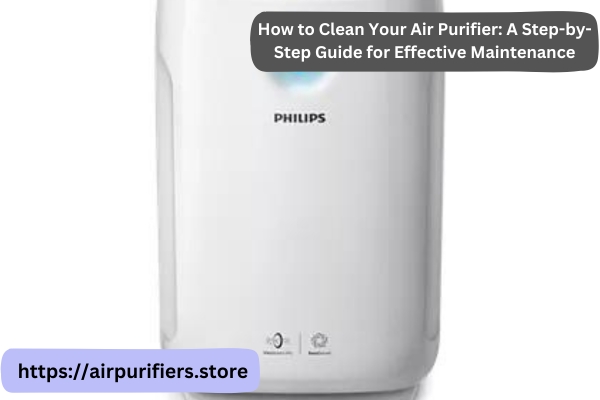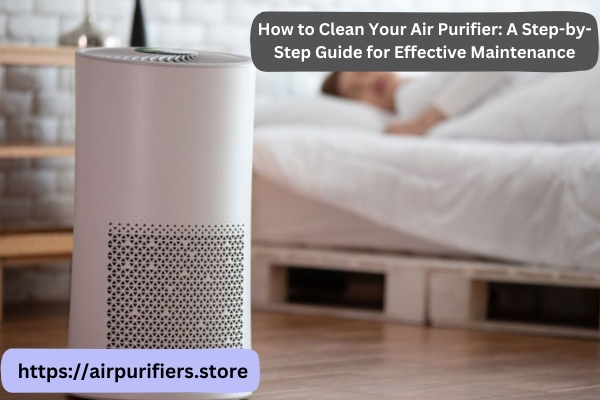How to Clean Your Air Purifier
Regularly cleaning your air purifier is essential for maintaining its efficiency and ensuring optimal air quality in your home. Over time, dust, allergens, and other particles can accumulate on the filters and hinder the purifier’s performance.
In this article, we will provide you with a comprehensive step-by-step guide on how to clean your air purifier effectively. By following these simple yet crucial maintenance steps, you can prolong the lifespan of your purifier and enjoy cleaner, fresher air for you and your family. (Buy On Amazon)
-
Read the Manufacturer’s Instructions:
Before attempting to clean your air purifier, it’s important to familiarize yourself with the manufacturer’s instructions. Each purifier model may have specific cleaning requirements and recommendations. Refer to the instruction manual or visit the manufacturer’s website for guidance on the appropriate cleaning methods and frequency.
-
Turn Off and Unplug the Air Purifier:
Ensure that the air purifier is turned off and unplugged from the power source before starting the cleaning process. This will prevent any potential electrical accidents and ensure your safety during the maintenance procedure.
-
Remove and Clean the Pre-Filters:
Most air purifiers have a pre-filter that captures larger particles like dust and pet hair. Check if your purifier has a removable pre-filter and remove it according to the manufacturer’s instructions.
Rinse the pre-filter under running water or gently vacuum it to remove debris. Allow it to dry completely before reinserting it into the purifier.
-
Clean or Replace the HEPA Filters:
High-efficiency particulate Air (HEPA) filters are essential for trapping smaller particles like pollen and allergens. Refer to the manufacturer’s instructions to determine if your HEPA filter is washable or replaceable. If washable, gently rinse the filter under running water or soak it in a mild detergent solution.
Avoid using harsh chemicals or scrubbing vigorously, as this can damage the filter’s effectiveness. If the filter is non-washable, replace it with a compatible filter as recommended by the manufacturer.
-
Clean the Exterior and Controls:
Wipe down the exterior surfaces of the air purifier using a soft, damp cloth. Pay attention to buttons, knobs, and control panels, ensuring they are free from dust and grime.
If necessary, use a mild detergent solution to remove stubborn stains or fingerprints. Avoid spraying water directly onto the purifier or immersing it in water to prevent damage.
-
Vacuum the Air Intake and Vents:
Using a brush attachment, gently vacuum the air intake and vents of the air purifier. This will help remove any accumulated dust or debris that may obstruct airflow. Pay special attention to the areas around the fan and motor, as these are common areas where dirt can accumulate.
-
Reassemble and Power On:
Once all the components are clean and dry, reassemble the air purifier according to the manufacturer’s instructions. Ensure that the filters are properly secured and the pre-filter is correctly inserted. Plug in the purifier and power it on to resume its normal operation.
-
Follow a Regular Cleaning Schedule:
To maintain optimal air purification performance, establish a regular cleaning schedule for your air purifier. The frequency of cleaning will depend on factors such as the manufacturer’s recommendations, usage, and the air quality in your environment.
As a general guideline, aim to clean the filters and perform basic maintenance every 3 to 6 months or as advised by the manufacturer.
9. Cleaning Frequency:
The frequency of cleaning your air purifier will depend on various factors such as the manufacturer’s recommendations, the level of air pollution in your area, and the specific model of your purifier. Some purifiers come with indicator lights or alerts that signal when it’s time to clean or replace the filters.
Additionally, if you notice a decrease in air purifying performance or an increase in dust and allergens in your home, it’s a good indication that cleaning is needed.
10. Cleaning the Ionizer:
If your air purifier has an ionizer feature, it’s important to clean it regularly as well. Ionizers release charged particles into the air to neutralize pollutants, but over time, these particles can accumulate on surfaces.
Follow the manufacturer’s instructions to clean the ionizer, which may involve wiping it with a soft, damp cloth or using a brush attachment on a vacuum cleaner.

11. Deep Cleaning:
In addition to regular maintenance, consider performing a deep cleaning of your air purifier at least once a year. This involves a more thorough cleaning of the internal components, such as the fan and motor. Consult the manufacturer’s instructions for guidance on how to access and clean these parts properly.
12. Replacement Filters:
While some filters are washable and reusable, others may need to be replaced periodically. Check the manufacturer’s instructions to determine the lifespan of your filters and when they should be replaced.
It’s important to use genuine replacement filters to ensure optimal performance and compatibility with your air purifier.
13. Odor Control:
If your air purifier has activated carbon or charcoal filters, they may help reduce odors in your home. However, these filters can become saturated and lose their effectiveness over time. If you notice persistent odors despite regular cleaning, it may be time to replace the activated carbon or charcoal filters.
14. Regular Maintenance:
Along with cleaning the filters, it’s important to keep up with other routine maintenance tasks. This includes checking the power cord for any damage, inspecting the seals and gaskets for leaks, and ensuring that the air purifier is placed in an area where it can intake and expel air freely.
Conclusion:
Cleaning your air purifier regularly is vital for ensuring its efficiency and maintaining clean indoor air quality.
By following the step-by-step guide provided in this article, you can effectively clean and maintain your air purifier, prolonging its lifespan and optimizing its performance.
Remember to consult the manufacturer’s instructions for specific cleaning guidelines and recommendations. With proper maintenance, your air purifier will continue to provide you and your family with fresher, healthier air for years to come.


